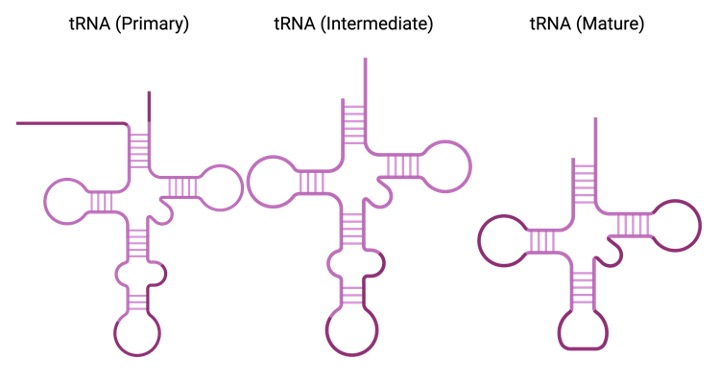Table of Contents
tRNA Definition
tRNA is a ribonucleic acid RNA that is involved in protein synthesis, specifically delivering certain amino acids to the ribosome for addition to the developing polypeptide chain.
What is tRNA?
Ribonucleic acid (RNA) is a nucleic acid composed of linear chains of monomeric nucleotides, comparable to deoxyribonucleic acid (DNA). Phosphoric acid, sugar, and nitrogenous bases make up each nucleotide component in turn. RNA varies from DNA in that it is usually single-stranded and contains ribose sugar rather than DNA’s deoxyribose sugar.

Another notable distinction is the presence of uracil in RNA rather than thymine in DNA. As a result, in RNAs, adenine complementary base pairs with uracil. Protein synthesis is one of RNA’s primary activities.
This process involves three forms of RNA: (1) messenger RNA (mRNA), (2) transfer RNA (tRNA), and (3) ribosomal RNA (rRNA). Transfer RNA transfers particular amino acids to the ribosome during protein synthesis so they may be added to the developing polypeptide chain.
tRNA Structure
tRNA (transfer ribonucleic acid) is usually made up of 76 to 90 nucleotides. It has a molecular mass of 25,000 to 30,000 Daltons. It may contain uncommon nucleotides such as pseudo uracil, inosine, and dihydroxy uridine in addition to the typical nucleotides like adenine, cytosine, guanine, and uracil. “

The fundamental structure of tRNA is a molecule made up of a certain nucleotide sequence. It takes the form of a sequence of nucleotides given in a certain order from the 5′ to the 3′ ends. The cloverleaf structure of tRNA is a two-dimensional (2D) arrangement generated by hydrogen bonding.
The L-shaped 3D structure generated by coaxial stacking of the helices is the tertiary structure of tRNA. Certain nitrogenous bases, nitrogenous bases with the ribose-phosphate backbone, and ribose-phosphate backbones all form hydrogen bonds.
tRNA Function
tRNA is a ribonucleic acid that carries a particular amino acid from the cytoplasm to the ribosome, where it is added to the expanding amino acid chain. In essence, it has two primary areas that are crucial in protein synthesis: one that links to the mRNA codon through the tRNA anticodon and the other that acts as an amino acid attachment site.

In prokaryotes, tRNAs are made in the cytoplasm, but in eukaryotes, they are made in the nucleus. The transcription of pre-tRNAs encoded by the tRNA genes is aided by RNA polymerase III. When there are four or more thymidine’s, transcription comes to a halt. After then, the pre-tRNAs will be matured.
By folding and cutting RNA, they develop into mature functioning tRNAs (i.e., removing the introns through tRNA-splicing endonucleases). Introns are eliminated by self-splicing in bacteria. The enzyme multifunctional tRNA ligase re-joins the spliced tRNAs after trimming. tRNAs are aminoacylate before being transported to the cytoplasm. The transfer of mature tRNAs into the cytoplasm is aided by Los1/Xpo-t.
Transcription and translation are the two steps that make up protein synthesis. Transcription is the process of generating messenger RNA (mRNA) from a DNA template. The mRNA travels from the nucleus to the cytoplasm to reach the ribosomes, which are responsible for protein synthesis. Translation takes place in the ribosome.
When the amino acids carried by tRNAs are linked together in a certain order as defined by the genetic code as transcribed by mRNA from a DNA segment, this is known as translation. The ribosome is a cytoplasmic structure that is used to synthesise proteins. There are three binding sites: A, P, and E. The aminoacyl-tRNA attaches to the A site (a tRNA with an amino acid).
The P site in a ribosome is occupied by the tRNA that carries the developing peptide chain (i.e., peptidyl tRNA). On its way out of the ribosome, decylated tRNA passes through the E site. The ribosome traverses each codon and pairs it with a specific amino acid linked to a transfer RNA using messenger RNA as a template. Soluble ribonucleic acid (RNA) and acceptor ribonucleic acid (RNA) are synonyms for transfer ribonucleic acid.
tRNA Citations
- tRNA introns: Presence, processing, and purpose. Wiley Interdiscip Rev RNA . 2020 May;11(3):e1583.
- tRNA Modifications: Impact on Structure and Thermal Adaptation. Biomolecules . 2017 Apr 4;7(2):35.
- tRNA biology charges to the front. Genes Dev . 2010 Sep 1;24(17):1832-60.
- Figures are created with BioRender.com







